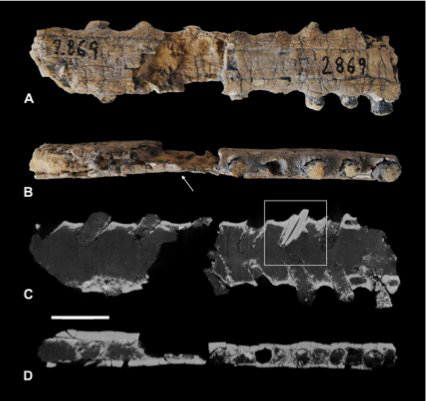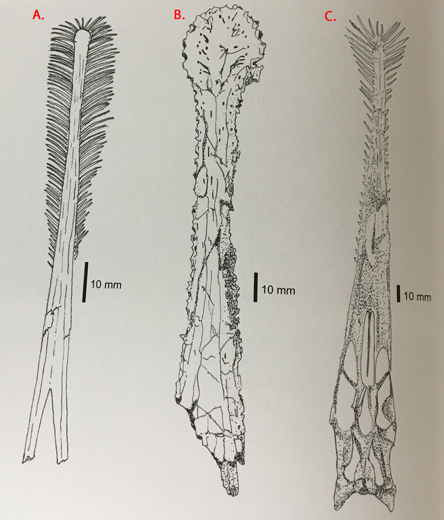Uruguay’s First Pterosaur
A team of international scientists writing in the academic publication “The Journal of South American Earth Sciences”, have reported the discovery of the first pterosaur fossils known from Uruguay. The fossil material representing a fragment of jaw with associated teeth, is believed to represent a new species of Ctenochasmatidae pterosaur. Ctenochasmatids are geographically widespread with fossils reported from the United States, China, southern Germany, Argentina and England. The fossils ascribed to this family of short-tailed pterosaurs have a large temporal range, from the Late Jurassic transitioning through to the Early Cretaceous.
Views of the Fragmentary Fossil Material (Rostrum)

Picture credit: The Journal of South American Earth Sciences
Buck-Toothed Pterosaur
The fossil comes from the Tacuarembó Formation, which is believed to represent deposits laid down as the early Atlantic Ocean opened up. The strata largely consists of sediments deposited in a terrestrial, near-shore environment. The orientation of the tooth sockets and the preserved tooth base suggests that the conical teeth were pointed out sideways and forwards. This may have been an adaptation for capturing slippery prey such as small fish. This family of small pterosaurs exhibit a variety of different shaped mandibles, although fragmentary, the researchers have identified that the fossil jaw widens towards the tip (anterior portion), the shape of the jaw and its size corresponds to jaws of known ctenochasmatids, specifically the subfamily Gnathosaurinae.
Different Jaw Types within the Ctenochasmatidae

Picture credit: Wellnhofer, Howse et al from Witton
The picture shows mandible variation within the Ctenochasmatidae (A) Ctenochasma elegans seen from below, (B) Plataleorhynchus streptorophodon as viewed from below and (C), the skull of Gnathosaurus subulatus (viewed from underneath). The dentition and the shape of the mandibles suggest adaptations for catching and consuming different types of prey.
Dating the Geological Formation Thanks to a Shark
The Tacuarembó Formation has proved very difficult to date, as the fossils found in the strata were not that easy to compare to fossils found in other rocks. Despite, an abundance of bone fragments representing a range of creatures, including theropod dinosaurs, the Tacuarembó Formation lacked helpful biostratigraphic indicator fossils to assist with relative dating. This changed with the discovery of numerous teeth and a single dorsal spine which was assigned to the Hybodont shark Priohybodus arambourgui.
Fossils of this primitive shark are known from the Arabian Peninsula as well as Africa and the strata associated with these fossils has permitted more accurate dating to occur. Thanks to this shark, the authors of this new paper can state that the pterosaur fossil material comes from a fossiliferous horizon no older than the Late Jurassic. As such, the Uruguayan pterosaur remains represent the oldest ctenochasmatid found in South America known to science.
For replicas of pterosaurs and other prehistoric animals: Prehistoric Animal Figures Including Pterosaur Models.






Leave A Comment